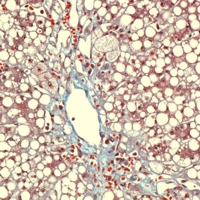Idiopathic Hyperammonemia in a Patient with Total Pancreatectomy and Islet Cell Transplantation
Abstract
Context Idiopathic hyperammonemia is characterized by elevated serum ammonia associated with neurological deterioration of no other obvious etiology associated with relatively normal liver function tests and normal amino-acid levels. Case report We report a case of a 32-year-old woman who presented with acute mental status changes with a pelvic abscess approximately a year following her total pancreatectomy and islet cell transplant surgery. Her ammonia level was elevated to 425 μg/dL. Traditional ammonia-reducing therapies were initiated, but proved ineffective. Metabolic, pharmacologic, microbial, and autoimmune causes for hyperammonemia were excluded. The patient ultimately required continuous veno-venous hemofiltration to decrease her ammonia. Ammonia levels decreased following continuous veno-venous hemofiltration and the patient’s mental status gradually returned to baseline. Conclusion Idiopathic hyperammonemia in the setting of total pancreatectomy and islet cell transplantation has not been reported before. We propose that malnutrition following total pancreatectomy resulting in repressed urea cycle enzyme synthesis may have predisposed for this hyperammonemia.
Image: Liver biopsy showing signs of cholestasis with pericentral and pericellular fibrosis.
Downloads
References
Davies SM, Szabo E, Wagner JE, Ramsay NK, Weisdorf DJ. Idiopathic hyperammonemia: a frequently lethal complication of bone marrow transplantation. Bone Marrow Transplant 1997 -> [PMID 8807124]
Mitchell RB, Wagner JE, Karp JE, Watson AJ, Brusilow SW, Przepiorka D, et al. Syndrome of idiopathic hyperammonemia after high-dose chemotherapy: review of nine cases. Am J Med 1988; 85:662-7. [PMID 3189370]
Watson AJ, Chambers T, Karp JE, Risch VR, Walker WG, Brusilow SW. Transient idiopathic hyperammonaemia in adults. Lancet 1985; 326:1271-4. [PMID 2866337]
del Rosario M, Werlin SL, Lauer SJ. Hyperammonemic encephalopathy after chemotherapy. Survival after treatment with sodium benzoate and sodium phenylacetate. J Clin Gastroenterol 1997; 25:682-4. [PMID 9451687]
Ho AY, Mijovic A, Pagliuca A, Mufti GJ. Idiopathic hyperammonemia syndrome following allogenic peripheral blood progenitor cell transplantation (allo-PBPCT). Bone Marrow Transplant 1997; 20:1007-8. [PMID 9422485]
Tse N, Cederbaum S, Glaspy JA. Hyperammonemia following allogeneic bone marrow transplantation. Am J Hematol 1991; 38:140-1. [PMID 1951305]
Snyder MJ, Bradford WD, Kishnani PS, Hale LP. Idiopathic hyperammonemia following an unrelated cord blood transplant for mucopolysaccharidosis I. Pediatr Dev Pathol 2003; 6:78-83. [PMID 12481230]
Lichtenstein GR, Kaiser LR, Tuchman M, Palevsky HI, Kotloff RM, O'Brien CB, et al. Fatal hyperammonemia following orthotopic lung transplantation. Gastroenterology 1997; 112:236-40. [PMID 8978364]
Samtoy B, Debeukelaer MM. Ammonia encephalopathy secondary to urinary tract infection with Proteus mirabilis. Pediatrics 1980; 65:294-7. [PMID 6444460]
Stanley CA. New genetic defects in mitochondrial fatty acid oxidation and carnitine deficiency. Adv Pediatr 1987; 34:59-88. [PMID 3318304]
Glasgow AM, Cotton RB, Dhiensiri K. Reye's syndrome. I. blood ammonia and consideration of the non-histologic diagnosis. Am J Dis Child 1972; 124:827-33. [PMID 4639217]
Nott L, Price TJ, Pittman K, Patterson K, Fletcher J. Hyperammonemia encephalopathy: an important cause of neurological deterioration following chemotherapy. Leuk Lymphoma 2007; 48:1702-11. [PMID 17786705]
Fine P, Adler K, Gerstenfeld D. Idiopathic hyperammonemia after high-dose chemotherapy. Am J Med 1989; 86:629. [PMID 2712077]
Coulter DL, Allen RJ. Hyperammonemia with valproic acid therapy. J Pediatr 1981; 99:317-9. [PMID 6788925]
Grazer RE, Sutton JM, Friedstrom E, McBarron FD. Hyperammonemia encephalopathy due to essential amino acid hyperalimentation. Arch Intern Med 1984; 144:2278-9. [PMID 6437358]
Limketkai BN, Zucker SD. Hyperammonemic encephalopathy caused by carnitine deficiency. J Gen Intern Med 2008; 23:210-3. [PMID 18080167]
Brusilow SW, Horwich AL. Urea cycle enzymes. In: Scriver CR, Valle D, Beaudet AL, et al, eds. The Metabolic and Molecular Basis of Inherited Disease. 7th ed. New York: McGraw Hill, 1995: 1187-1232. [ISBN 978-0079130358]
Felig DM, Brusilow SW, Boyer JL. Hyperammonemic coma due to parenteral nutrition in a woman with heterozygous ornithine transcarbamylase deficiency. Gastroenterology 1995; 109:282-4. [PMID 7797025]
Gilchrist JM, Coleman RA. Ornithine transcarbamylase deficiency: adult onset of severe symptoms. Ann Intern Med 1987; 106:556-8. [PMID 3826955]
Carr RB, Shrewsbury K. Hyperammonemia due to valproic acid in the psychiatric setting. Am J Psychiatry 2007; 164:1020-7. [PMID 17606652]
Morsy MR, Madina H, Sharaf SA, Soliman AT, Elzalabany MM, Ramadan MA. Hyperammonemia in Marasmic children. J Trop Pediatr 1994; 40:97-9. [PMID 8015039]
Rebouche CJ. Kinetics, pharmacokinetics, and regulation of L-carnitine and acetyl-L-carnitine metabolism. Ann N Y Acad Sci. 2004; 1033:30-41. [PMID 15591001]

Copyright (c) 2010 Udayakumar Navaneethan, Preethi GK Venkatesh

This work is licensed under a Creative Commons Attribution 4.0 International License.
As a member of Publisher International Linking Association, PILA, iMedPub Group’s JOP follows the Creative Commons Attribution License and Scholars Open Access publishing policies. Journal of the Pancreas is the Council Contributor Member of Council of Science Editors (CSE) and following the CSE slogan Education, Ethics, and Evidence for Editors.